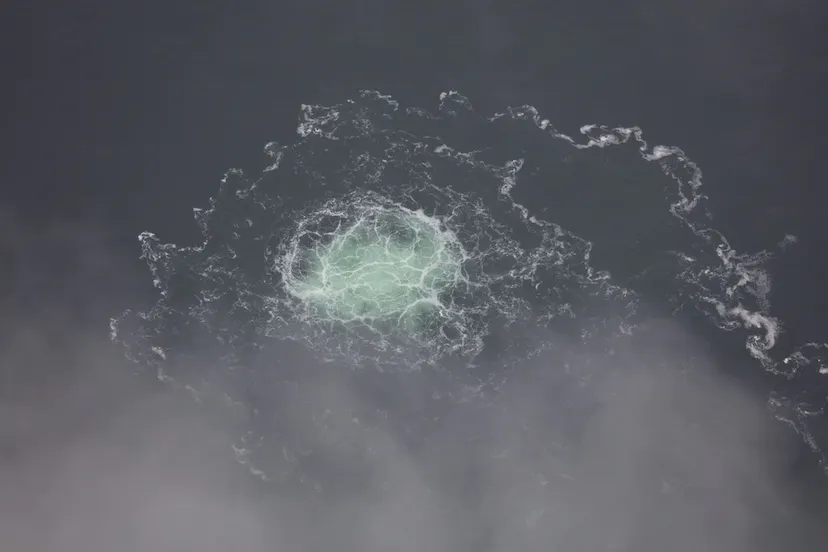 |
| Photo by Swedish Coast Guard via Getty Images | Share this story |
The amount of methane that routinely leaks from oil and gas infrastructure dwarfs the Nord Stream pipelines’ huge mess
This week, the world watched what’s likely to be the fossil fuel industry’s single largest methane release ever. An astonishing amount of methane is floating up from the now-notorious Nord Stream 1 and 2 pipelines and rising above the surface of the Baltic Sea. It’s a pollution nightmare. It also pales in comparison to the vast amount of methane that oil and gas operations constantly release.
Up to 778 million standard cubic meters of methane gas could spew from the Nord Stream 1 and 2 pipelines in a worst-case scenario, according to the Danish Energy Agency. That’s equivalent to nearly a third of Denmark’s greenhouse gas emissions for the entire year of 2020.
The Nord Stream disaster “is an extraordinarily huge one-time event,” says Andrew Baxter, a chemical engineer turned director of energy transition at the Environmental Defense Fund. “But it’s sort of emblematic of other massive emissions from the oil and gas industry of methane into the atmosphere.”
The Nord Stream disaster “is an extraordinarily huge one-time event”
As big as this event is, runaway gas from the Nord Stream pipelines amounts to a fraction of the methane that routinely escapes from oil and gas fields, pipelines, and other infrastructure. Faulty equipment can leak for weeks. Companies also “vent” gas — releasing it into the air — for well or pipeline maintenance or to keep pressure from building up to dangerous levels in their equipment. The oil and gas industry releases 82.5 million tons of methane emissions a year, by the International Energy Agency’s measure. That’s equivalent to the worst-case scenario for the Nord Stream disaster taking place every two days, Baxter tells The Verge. The US oil and gas industry alone releases methane at the rate of a Nord Stream disaster about every two and a half weeks, climate writer and analyst Ketan Joshi calculated.
To be perfectly clear, what’s happening with the Nord Stream 1 and 2 Gas Pipelines is far from ordinary. “All currently available information indicates that this is the result of deliberate, reckless, and irresponsible acts of sabotage,” NATO said in a press release yesterday. Vladimir Putin has also accused Western governments of sabotaging the pipelines. The pipelines, which run from Russia to Germany, are a physical embodiment of Western Europe’s reliance on gas, much of it coming from Russia. So before fears of sabotage, these pipelines were already a flashpoint for efforts to transition the European Union to clean energy.
Nor is it normal to see nearly half a mile of the surface of the sea roiling with methane. The Danish Armed Forces released mesmerizing video and images of the bubbling disaster in the Baltic this week. And while seawater can typically absorb most of methane from smaller underwater leaks, preventing it from floating up to the air, this isn’t the case with the Nord Stream disaster because of how enormous the leaks are.
“The sea cannot take in that volume,” says Mahmoud Khalifeh, an associate professor at the University of Stavanger who has researched gas leaks from offshore wells. Khalifeh expects more than 90 percent of the gas that escapes from the pipelines to make its way into the atmosphere.
He also points out that, unlike spilled oil that collects in the water, there’s not much that can typically be done to clean up leaking gas. It simply dissipates into the water and air. It’s also dangerous for authorities to send in personnel to deal with the mess. The air quality is too horrendous, and sending in vehicles to clean things up could spark a massive blaze. In Nord Stream’s case, however, Mahmoud thinks fire could mitigate some of the risks. Setting the methane ablaze would convert the plume to carbon dioxide, which can be 80 times less potent than methane as a greenhouse gas. It might also stop the methane from drifting ashore and polluting communities there. Lighting up excess gas, called flaring, is also a strategy oil and gas companies use to minimize methane emissions.
The UN Environment Programme released satellite images yesterday of the methane plume above the Nord Stream leaks. There are growing efforts to document methane leaks from space as an increasing body of research shows that many countries are likely undercounting how much methane is leaking from oil and gas operations.
“This is a special one-off event that’s got everyone’s attention. But the oil and gas industry emits millions of tons of methane every year, and that’s supercharging near-term [global] warming,” Baxter says. “I hope that this brings that into focus for more people, we need to be able to regulate [emissions from these] companies and take this extremely seriously.”
Read more here
No comments:
Post a Comment